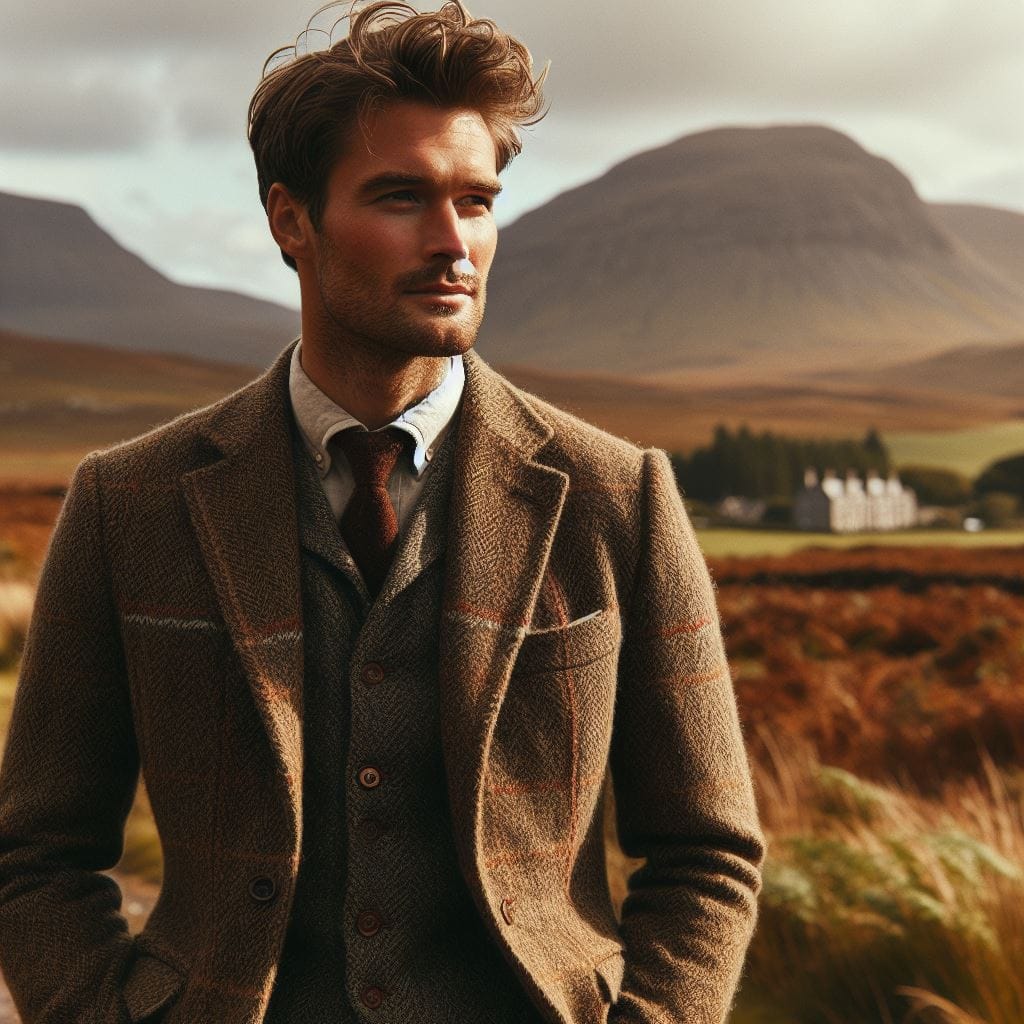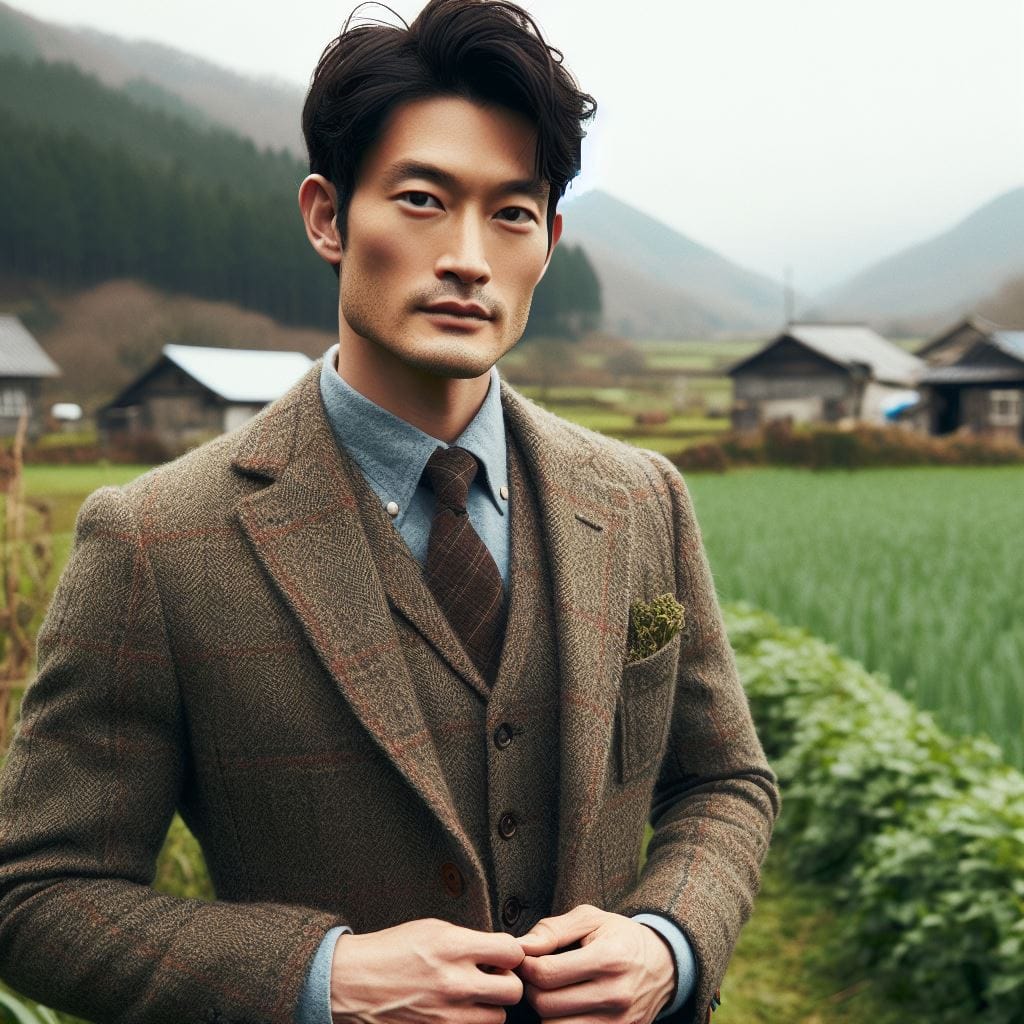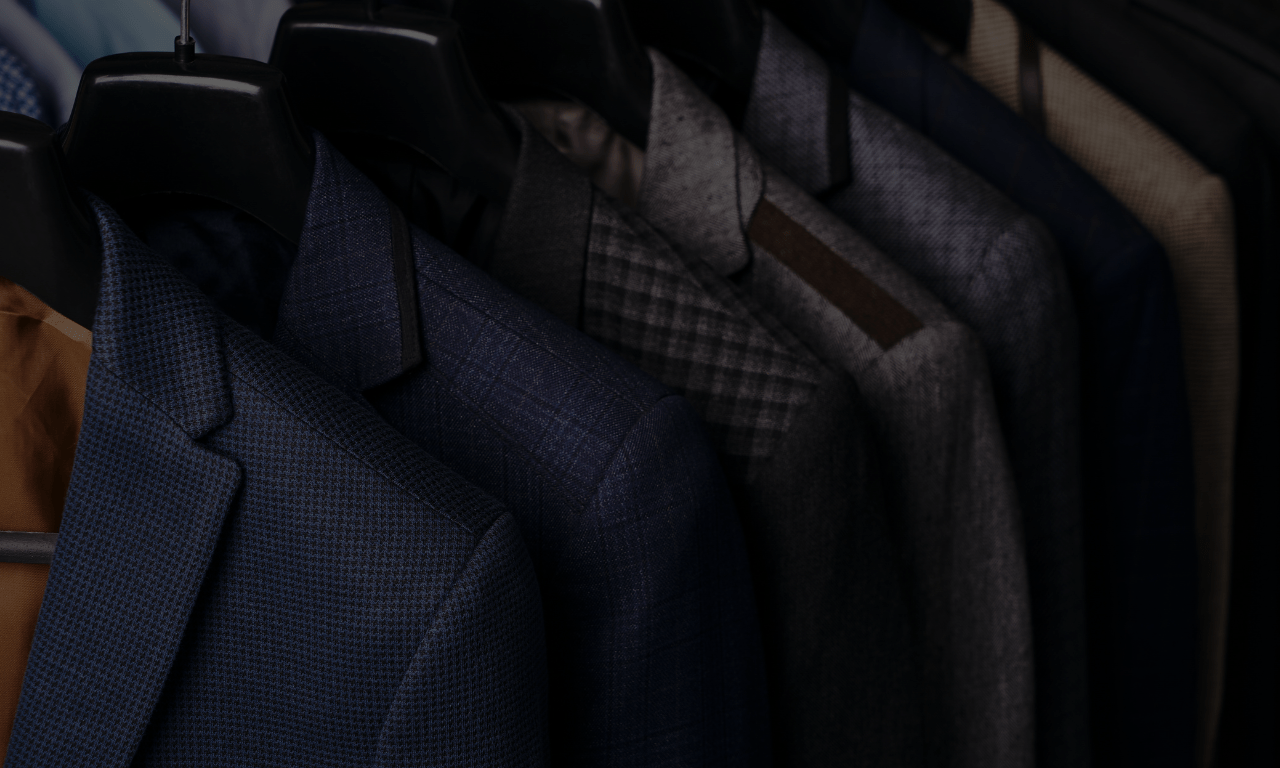
In the ever-evolving realm of men’s fashion, few garments have stood the test of time as resolutely as the sport coat. This quintessential piece of attire, bridging the gap between formal and casual, has witnessed a fascinating journey throughout history, adapting to changing societal norms and fashion trends. From its humble beginnings rooted in functionality to becoming a style statement, the sport coat’s evolution reflects the shifting paradigms of men’s fashion. Let’s delve into the rich history, cultural moments, and contemporary resurgence of sport coats, exploring how this timeless garment has seamlessly intertwined with shifting social norms and style preferences.
Table of Contents
Part 1: Predecessors to the Sport Coat

Prior to the specific emergence of sport coats, men’s fashion primarily revolved around formal suits or tailored jackets. The concept of a matching suit—comprising a jacket and trousers—became a staple during the 19th century, gaining immense popularity across various social strata. This ensemble was considered the standard attire for men, whether for business, formal occasions, or daily wear.
One precursor to the sport coat was the smoking jacket, which had its roots in earlier robe-like garments from India1. Smoking jackets originated in the mid-19th century and were designed for relaxation at home, particularly while smoking tobacco after dinner. They had a shawl lapel and grew in popularity while the popularity of smoking grew after the Crimean war2. Typically made from luxurious fabrics like velvet or silk, these jackets were less formal than suits but still embodied an air of elegance and sophistication.
As social norms evolved, the British aristocracy and upper classes began engaging in outdoor activities and leisure pursuits during the 19th century.3 This shift in lifestyle created a demand for attire that was more casual, comfortable, and suitable for such occasions. It was during this period that the groundwork for what would eventually become the sport coat began to take shape.
Although these jackets were more hardy and bore resemblances to what would later be known as sport coats, they were yet to be specifically coined as such. Their designs and functionalities catered more towards the practical needs of outdoor activities rather than being a distinct fashion statement in their own right.
This transition towards more relaxed and practical attire laid the groundwork for the eventual rise of sport coats. These precursors set the stage for the later refinement and evolution of jackets tailored specifically for sports and leisure, gradually leading to the development of what we recognize today as the modern sport coat.
Part 2: The Emergence of the First Sport Coat

The first iterations of what could be considered sport coats began to emerge as an adaptation of traditional tailored jackets. Initially, these coats were crafted from robust fabrics like tweed, which provided durability and weather resistance, ideal for outdoor pursuits.4 The design incorporated elements from shooting jackets and country attire, focusing on functionality over formality.
The Norfolk jacket, introduced around the 1860s, is often regarded as one of the earliest precursors to the modern sport coat.5 The name is said to come from the city of Norfolk and got popularized through Duck Hunting parties held by the 15th Duke of Norfolk. 6Characterised by its boxy silhouette, pleats, and belted back, the Norfolk jacket was initially designed for hunting and shooting activities. It featured practical details like patch pockets, sturdy lapels, and a distinct belt that offered ease of movement and comfort during such activities.

Around the same period, British sporting enthusiasts sought more comfortable and versatile clothing suitable for various leisure activities, such as yachting, golfing, and cycling. This led to the development of tailored jackets specifically designed for all these pursuits. Jackets made from durable materials like tweed or twill, often featuring distinct design elements like elbow patches or reinforced shoulders.
In the United States, a similar trend was observed with the adoption of tailored jackets for leisurely pursuits. The sack coat, an American variation, emerged in the late 19th century and shared some characteristics with the British sport coats. Initially, sack coats were worn primarily as casual attire and displayed a more relaxed fit compared to traditional suits.7
While these early versions of sport coats exhibited functional aspects and catered to specific activities, they were not yet identified or marketed as standalone garments for general use. It wasn’t until the early 20th century that the term “sport coat” started gaining prominence, signifying a distinct category of jackets designed for leisure activities and casual wear.
The transition from functional outerwear for sports to a more versatile, stylish garment suitable for various occasions marked a pivotal phase in the evolution of sport coats. This shift laid the groundwork for the broader acceptance and popularity of sport coats as a key element of men’s fashion in the coming decades.
Part 3: The Rise of the Sport Coat
The early 20th century witnessed a significant evolution in men’s fashion, with sport coats gradually gaining recognition as a stylish and versatile garment. As the socio-cultural landscape shifted and traditional dress codes relaxed, sport coats began to transition from specialized outdoor attire to a more widely accepted fashion staple.
Post-World War I, societal norms experienced a transformation, leading to a more casual approach to dressing. The aftermath of the war brought a desire for comfort and practicality, which impacted men’s fashion. As a response to this societal shift, tailors and designers refined the structure and appearance of sport coats, offering them as an alternative to traditional formal suits.
In the 1920s, sport coats gained momentum among the affluent and fashion-conscious gentlemen. These jackets, often made from tweed or flannel, featured distinctive characteristics such as wider lapels, patch pockets, and softer constructions compared to the structured suit jackets. They exuded a relaxed elegance that appealed to men seeking a less formal yet refined look.8
The ’30s witnessed further diversification in sport coat designs. Influences from European fashion and Hollywood’s Golden Age contributed to the jacket’s popularity. Hollywood icons like Clark Gable 9and Cary Grant10 popularized sport coats through their on-screen appearances, sparking trends and solidifying the garment’s status as a stylish choice for men.
Design innovations also emerged during this period, with tailors experimenting with a range of fabrics, patterns, and colours for sport coats. Herringbone, windowpane, and checked patterns became prevalent, offering gentlemen a wide array of choices. Notably, the introduction of the “soft shoulder” construction contributed to the sport coat’s casual elegance, making it distinct from traditional suits.
During the early part of the 1940s, the the war effort encouraged a more austere look as there was rationing of fabric11. That said after the war men embraced them as versatile wardrobe essentials suitable for various occasions. Fabric choices expanded to include lighter materials like linen and cotton, ideal for warmer climates or summer wear.
The post-World War II era marked a significant turning point for sport coats. The return of soldiers from war brought about changes in fashion sensibilities. As men re-entered civilian life, they sought garments that provided comfort and style without compromising on elegance. In the immediate aftermath of the war, a sense of optimism and a desire for normalcy swept through society. This optimism, coupled with a growing affluence in Western economies, influenced men’s fashion, including the continued rise of the sport coat. This period witnessed a surge in demand for sport coats as a middle ground between formal wear and casual attire.12
Part 4: The Sport Coat After World War II

The years following World War II marked a pivotal period for sport coats, witnessing further evolution and solidifying their status as a timeless menswear essential. The post-war era ushered in socio-cultural changes that significantly influenced fashion trends, leading to a redefined perception of men’s clothing.
During the 1950s, the sport coat underwent refinements in design and material. The prevalence of the Ivy League look, influenced by American universities, spurred a demand for tailored clothing that blended casualness with sophistication. Sport coats, often in earthy tones like olive, brown, and tan, became emblematic of this preppy style, featuring softer, natural shoulder lines and tailored silhouettes.13
Additionally, the advent of new materials and technological advancements impacted sport coat manufacturing. Fabrics like hopsack, twill, and corduroy gained popularity, offering a range of textures and patterns for discerning gentlemen. Innovations in textile blends and finishes allowed for more durable and wrinkle-resistant sport coats, catering to the active lifestyles of men seeking practical yet stylish clothing.
The 1960s witnessed a departure from the conservative fashion of the previous decade. The younger generation rebelled against traditional norms, embracing bold colors, unconventional patterns, and more relaxed fits. Sport coats mirrored these shifting preferences, adopting brighter hues, vibrant plaids, and bolder patterns, appealing to a more fashion-forward clientele.14
Designers and manufacturers continued to experiment with sport coat styles, offering variations in lapel widths, pocket styles, and lengths. Tailoring innovations, such as the introduction of the dartless sack coat, provided a more comfortable and relaxed fit, appealing to the growing population of men seeking freedom of movement and casual elegance.
By the 1970s, sport coats continued to reflect changing fashion sensibilities. The influence of disco culture and the proliferation of casual wear influenced sport coat designs. The decade saw the emergence of leisure suits, which incorporated elements of sport coats, blending formal elements with comfort and flair.15
However, the late ’70s and early ’80s marked a shift back towards traditional styles. The return to classic elegance saw a resurgence of traditional sport coat designs, emphasizing timeless fabrics like tweed and herringbone. Slimmer silhouettes and classic patterns regained prominence, as men sought a return to refined tailoring and sophistication.
Part 5: Sport Coats Trends – 1990s to 2010s
1990s:
The 1990s witnessed a style shift from the extravagance of the previous decade towards a more minimalistic approach. In menswear, this translated to a return to classic and tailored looks, and sport coats reflected this trend. The decade favoured clean lines, understated designs, and a move away from the bold patterns and flamboyance of the ’80s.
Early 2000s:
Retro Revival: The early 2000s saw a resurgence of interest in vintage styles. This impacted sport coats, with nods to the refined cuts and designs of earlier eras. There was a resurgence of appreciation for tweed and houndstooth patterns, blending nostalgia with contemporary tailoring.
Mid to Late 2000s:
Casualization: As workplaces adopted more casual dress codes, sport coats adapted to suit the changing environment. The mid to late 2000s witnessed the integration of sport coats into more casual ensembles. Blazers, often made with lighter materials and softer constructions, became acceptable attire in semi-formal and casual settings.
The 2010s:

Return to Tailoring: Toward the end of the decade, there was a renaissance in tailored menswear. Influenced by various style movements and the rise of men’s fashion influencers on social media platforms, the 2010s saw a renewed appreciation for bespoke and well-fitted clothing, including sport coats.
Eco-consciousness: With increasing awareness of sustainability, there was a growing interest in ethical fashion choices. Natural and sustainable fabrics became more popular, influencing sport coat designs and materials.
Cultural Moments and Social Norms: Sport coats, traditionally considered a symbol of elegance and refinement, underwent transformations in line with changing social norms. As workplaces embraced more relaxed dress codes, sport coats adapted to accommodate this shift. The concept of ‘smart casual’ evolved, allowing men to express their style in a more relaxed yet refined manner.
Cultural moments, such as red carpet appearances, celebrity endorsements, and fashion weeks, showcased the versatility of sport coats. These moments influenced trends and reinforced the notion that a well-tailored sport coat could be styled for various occasions, from formal events to everyday wear.
Sport coats became emblematic of a modern gentleman’s wardrobe, adapting to the evolving preferences for versatility, sustainability, and timeless style while reflecting the changing social norms and cultural movements of their time.
Part 6: Recent Trends in Sport Coats
In recent years, there has been a noticeable resurgence in interest in classic menswear, including sport coats. This revival can be attributed to several factors:
Contemporary fashion has leaned towards versatility, and sport coats offer just that. Brands are designing sport coats with adaptable features, allowing them to transition effortlessly from formal to casual settings. With a growing disdain for fast fashion and its disposable nature, consumers are gravitating towards investing in quality garments that withstand the test of time. As a result, there’s renewed appreciation for well-constructed and durable sport coats. Consumers are increasingly mindful of sustainable and ethical fashion. Many brands are responding by offering sport coats made from eco-friendly materials, promoting responsible manufacturing processes and fair labor practices.
Made-to-measure and bespoke options have gained popularity. Brands and tailors are offering customization services for sport coats, allowing customers to create unique pieces that fit perfectly and reflect their individual style Contemporary designers are merging traditional tailoring techniques with modern aesthetics. This fusion results in sport coats that retain classic elements while embracing innovative designs, patterns, and materials. The resurgence of sport coats is indicative of a broader shift in menswear, emphasizing timeless style, craftsmanship, and sustainability. It reflects a move away from disposable fashion and encourages consumers to invest in quality pieces that transcend fleeting trends. This renewed interest in classic menswear ensures that sport coats continue to hold a prominent place in the modern gentleman’s wardrobe.
The journey of the sport coat traverses eras, from its inception to contemporary trends. This iconic garment, embodying a fusion of elegance and versatility, remains an essential element in modern menswear. As fashion continues to evolve, the sport coat stands as a testament to timeless sophistication and adaptable style. Its resurgence in recent years signifies a return to sartorial elegance, emphasizing quality, sustainability, and personal expression. In an era where fashion trends often come and go, the sport coat endures as a classic, exuding refinement and a nod to tradition while embracing the spirit of innovation. Its remarkable journey through history assures its continued relevance, securing its place in the wardrobe of the discerning modern gentleman.
With the changing international trading atmosphere however, affordable classic menswear may cause new trends to emerge. After all fashion, even timelessness attire, is not entirely disconnected from the politics, mindsets, and economics of the era. Will increasing costs change the Sports Coat once more?
- https://www.gentlemansgazette.com/smoking-jacket-guide/ ↩︎
- McCormack, Derek (December 18, 2007). “Consider the smoking jacket”. Edmonton Journal. Archived from the original on October 6, 2011. Retrieved 2009-02-12 ↩︎
- Baker, W. J. (1979). The Leisure Revolution in Victorian England: A Review of Recent Literature. Journal of Sport History, 6(3), 76–87. http://www.jstor.org/stable/43609011 ↩︎
- https://ca.ahume.co.uk/blog/the-origins-of-the-sport-jacket/ ↩︎
- https://web.archive.org/web/20200308170642/https://houseoflucan.com/product/norfolk-jacket-blue/ ↩︎
- ibid. ↩︎
- https://lilyabsinthe.com/a-brief-view-of-mens-clothing-the-sack-coat-2/ ↩︎
- https://vintagedancer.com/1920s/1920s-mens-fashion-the-suit/ ↩︎
- https://www.otaa.com/blogs/journal/how-to-dress-like-clark-gable ↩︎
- https://www.gentlemansgazette.com/cary-grant-gentleman-style/ ↩︎
- https://fashionhistory.fitnyc.edu/1940-1949/ ↩︎
- https://fashionhistory.fitnyc.edu/1940-1949/ ↩︎
- https://www.ivy-style.com/the-rise-and-fall-of-the-ivy-league-look.html ↩︎
- https://vintagedancer.com/1960s/1960s-mens-suits-sport-coats-history/ ↩︎
- https://people.howstuffworks.com/leisure-suit.htm ↩︎

